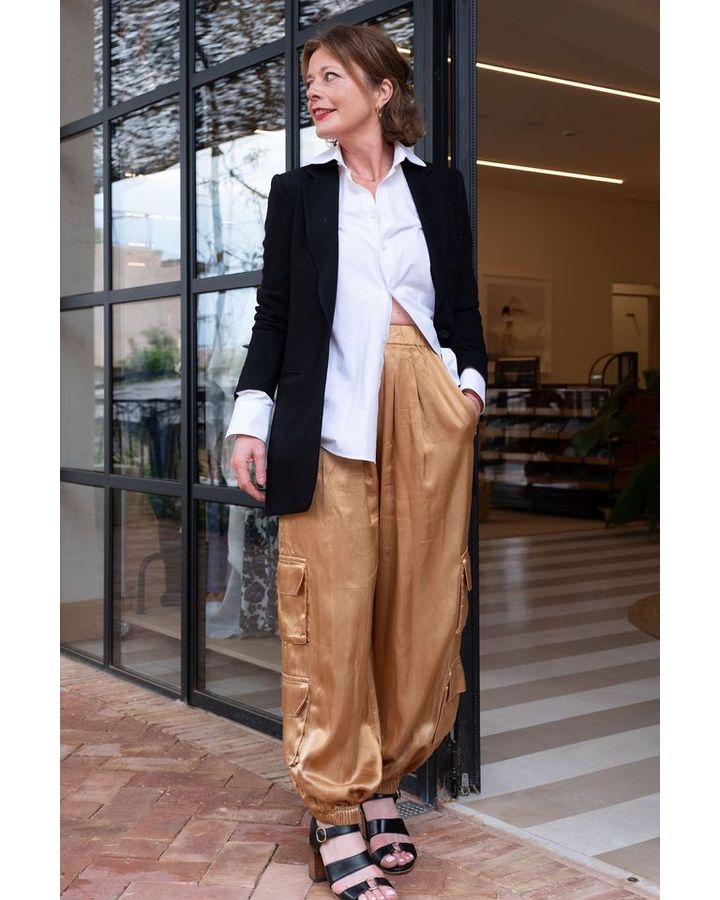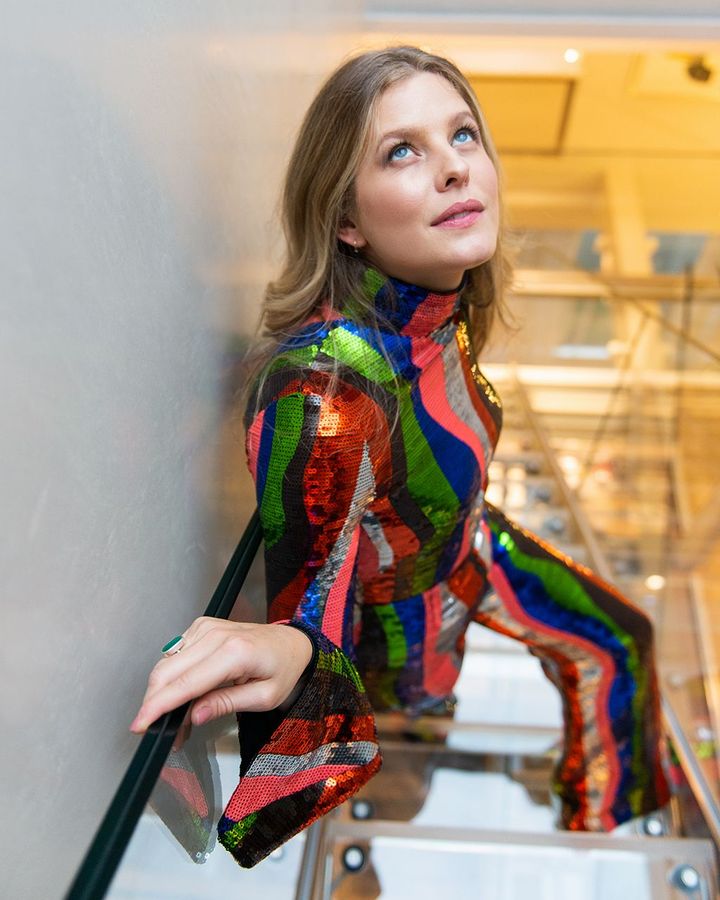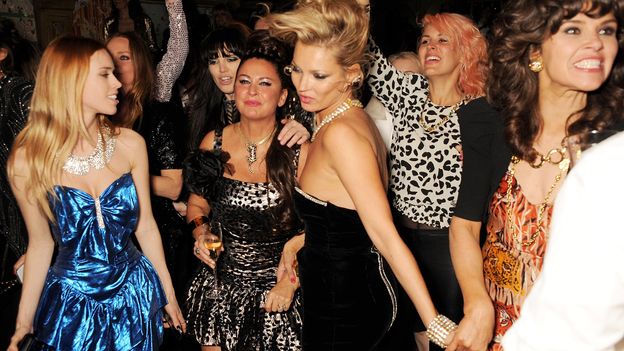(Image credit: Getty Images)
The party season is here – so what’s a conscious fashionista to wear? Bel Jacobs speaks to some eco-friendly party-goers and vintage experts about their tips and tricks for elegant evening wear.
C
Christmas comes early for fashion magazines, which start publishing party-dressing lists from mid-October. “We’re already gearing up for a spot of evening-wear shopping – because it’s never too early to get into the festive spirit, right?” chirruped one writer. But a quick glance at the selection reveals concerns. That slinky sequinned mesh mini-dress in midnight-blue from a fast-fashion brand? One hundred percent polyester. The shimmering figure-hugging midi-dress in nude? One hundred percent polyester. That pleated cut-out maxi dress with plunging V-neck in red “elevated satin”? One hundred percent polyester. And that was a luxury brand.
More like this:
– A guide to giving gifts sustainably
– How to avoid buying new clothes
– How to dye clothes at home – naturally
From shine to stretch, partywear is plastic-fantastic – and, as anyone engaged in the debates around pollution from fashion knows, that’s not good. Synthetics, derived from fossil fuels, don’t biodegrade; instead, they poison the Earth, plague marine life and turn ocean habitats into plastic soup for centuries to come. According to Changing Markets, 69% of everyday fashion is made from synthetic fibres, including elastane, nylon and acrylic and – top pick for fast fashion – polyester. If the three dresses above are anything to go by, that percentage is likely to be higher in party wear.

Sustainability expert and author Aja Barber buys her glamorous party wear from second-hand style platforms (Credit: Aja Barber)
It’s not surprising. For a fashion brand eager to shift product, nothing replicates the luxurious textures of yesteryear as cheaply as synthetics. But, as the invites start piling up, what’s a conscious fashionista to do? “The very last thing? Buying something new,” says Aja Barber, author of Consumed, which drills down into our shopping habits through the lenses of colonialism, climate change and consumerism. It’s a theme that now runs through most fashion activism: when facing an industry that produces more than 100 billion items of clothing a year, and then chucks away about 90% of that into landfill or incineration, using what we already have is our most powerful riposte.
Last year, inspired by the 2022 report on consumption by the Hot or Cool Institute, former editor-in-chief of Harrods magazine Tiffanie Darke launched the Rule of 5, a campaign encouraging followers to buy just five new items of clothes a year. “We tend to wear about 30 percent of our wardrobe so there are bound to be treasures in there,” she says. “Then, get creative with them.” In the ethical fashion universe, styling – putting clothing together in imaginative ways – really is the new design. “I have a black leather mini dress which is no longer appropriate,” offers Darke. “But, worn with a white man’s shirt, some lacy black tights and a slick of red lipstick, it’s suddenly very okay.”

Model Kate Moss is a long-time supporter of vintage fashion for party wear (Credit: Getty Images)
It’s a fashion lover’s mantra: pump up a little black dress with bold accessories. “A strong lip, a great manicure, some polka-dot 15 denier tights or one piece of strong statement jewellery,” advises Darke. But whatever accessory you choose, make sure it’s ethical.
“I love jeweller Phoebe Walsh,” says ethical-fashion enthusiast and synth-pop artist Lydia Baylis. “She makes bespoke pieces, using 100% recycled gold and silver; she also offers credit if you donate anything to their recycling program. Everlane makes great mules completely out of recycled plastic water bottles.”
Video: Upcycling fashion from remnants
Try customising – turning one piece of clothing into another, with the help of a professional if you’re not skilled up enough yet. “There’s a girl on TikTok whose rabbit ate her silk Prada dress and upcycling specialist Save Your Wardrobe turned it into a brilliant skirt for her,” laughs Darke. “I turned an orange taffeta dress into a peplum top with the help of Splendid Stitches: they used the skirt to lengthen the sleeves.” Sojo, which offers door-to-door clothing repairs and alterations, and The Seam, which will match you with a local maker, are two more apps that connect members with brilliant seamstresses, she adds.
Some online services that pair rips with repairers specialise in certain types of items. REI offers mending services for outdoor clothing (a big win-win, as active clothing is often synthetic-heavy); Denim Therapy also tackles one of fashion’s most resource-intensive fibres. Coblrshp looks to footwear. For more general services, turn to Alterknit. Ethical brand Patagonia works to keep as many of its own clothes in circulation for as long as possible.
Party on
Styling inspiration is everywhere – from vintage-loving models like Kate Moss, to second-hand-fashion influencers. “Social media is a great place to get inspiration,” says Baylis. She likes @justmelines on Instagram where LA-based stylist Melina Marissa puts together lots of mostly second-hand looks. And clever styling makes a garment work for different moods and occasions. “I’ve worn my black velvet suit endlessly over the last 10 years,” says Baylis. “You can make it smart with a white shirt and loafers, go for dinner in a new romantic 70s style with a pussybow shirt and ankle boots, or sex it up with a high heel and lace bralet.”
Sustainable partywear tips
– Get inspired to style up old outfits by turning to the professional stylists on social media
– Buy a timeless investment piece you can wear in a dozen different ways
– Consider renting party shoes – most footwear is resource-heavy and polluting
– Sometimes, less is more
Second-hand comes up again and again. “I’ve gotten to a point where 80% of my wardrobe is now second hand,” admits Barber. “It’s the first place I go.” For Barber, eBay and Vestiaire Collective are stalwarts. Artist and climate activist – and former teen fashion blogger – Tolmeia Gregory agrees: “Charity shops or independent vintage stores are great – and more and more are adding vintage sections to their stores.” Baylis adds: “Karen Vintage on Portobello Road is amazing – and the Shelter [charity] shop in Maida Vale [London] has great second-hand clothes too,” Baylis adds.
Every stylist has a favourite era. “I love 70s style,” says Baylis. “You can choose between a more romantic, flowing shirt or dress or more form-fitting trousers. I love the colours and the flares.” Darke agrees: “70s, definitely. I have a velvet flared tuxedo suit I always feel amazing in.” How does she wear it? “With a gold Diane von Furstenberg vest so it looks good with and without the jacket. Incorporating a cover-up that can easily be discarded for the dancefloor is a nice vibe.”

Tiffanie Darke, founder of the Rule of 5 campaign, believes that ‘less is more’ (Credit: Story Studios)
Gregory adds: “I love 1920s style. It’s fun and playful. Yes, it does involve sequins but that can be replicated by layering jewellery.” Few sustainable fashionistas like sequins; those small glittering discs hold a world of hurt. “Most are derived from fossil fuels and then manufactured poorly,” warns Gregory. Try “slow fashion”, suggests Darke. “Again, good-quality charity shop finds are an acceptable way to source glitter… ” Then wear those pieces across seasons.
“Glitter does shout festive – but it doesn’t have to be exclusively for[the festive season],” advises Baylis. “I have a pair of silver sequinned trousers I’ve worn to weddings, to Halloween parties – and on stage. The key is to re-wear and re-style pieces all year round so that they get the most use.” And why limit shine to clothing, asks Darke. “Lots of beauty brands do metallic and glittery eye colours and lipsticks. Wear something plain and then let your face do the talking…” Again, choose cruelty-free, ethical and vegan wherever possible.
It’s also worth considering an alternative to fur, real or synthetic. Many compassionate brands have dropped it anyway. You could borrow – or ditch the aesthetic and its connotations of cruelty altogether. “Cosy up an existing jacket or coat with a big, broad scarf, double wrapped around your neck, or try turning a blanket into a poncho. I did once come across someone who turned their broken sleeping bag into a duvet coat, which was rather inspiring.” Baylis adds: “Over-sized men’s jackets can look really cool. Things always come back into fashion.”
Clothing rental is one of the most concrete ways to re-use clothes. Bayliss is a curator at rental platform Cercle, where she offers a selection of dresses and footwear from her own wardrobe. “Rental is an amazing way to find glamorous, new things to wear. I have a pair of Dolce & Gabbana shoes on Cercle. I love the idea they are out there getting more nights of dancing!”
Barber enjoys By Rotation. Then there are clothes swaps. “Where you bring something you no longer wear, and swap it with something else,” says Baylis. “It’s a clever way to give your clothes another life.”

A curator at fashion rental platform Cercle, Lydia Baylis swears by rented and vintage gems for her party looks (Credit: Cercle)
Finally, if you really do have to buy something, opt for an ethical alternative, beautiful in presentation and production. “View your purchases as a future investment rather than a one-off for an event; buy something you’d want to wear again and again so that, when the time comes, you just reach for it,” says Gregory. Barber adds: “Unless it’s something you’ll wear 50 times, don’t get it.”
To help you along the way, ditch one of the most destructive myths in the industry: that you can’t wear something twice. We’re the first generation to think like this, and the concept is rebounding on us. “The likelihood is, nobody will notice,” Gregory points out. “And, if they do, it’s a great conversation starter about why we all need to start dressing more responsibly.”
If you liked this story, sign up for the weekly bbc.com features newsletter, called The Essential List. A handpicked selection of stories from BBC Future, Culture, Worklife and Travel, delivered to your inbox every Friday.
If you would like to comment on this story or anything else you have seen on BBC Culture, head over to our Facebook page or message us on Twitter.
;

